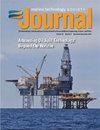AI‐ML-Enabled Electromagnetic Homing Guidance System for Scientific Autonomous Underwater Vehicles
IF 0.7
4区 工程技术
Q4 ENGINEERING, OCEAN
引用次数: 1
Abstract
Abstract Subsea homing and docking systems are used for increasing the spatiotemporal capabilities of autonomous underwater vehicles (AUVs) involved in long endurance scientific, survey, and surveillance missions. They offer necessary guidance for the AUV, and maneuver into the dock, considering the vehicle attitude and the dynamic response capabilities. Short-range homing is critical for successful docking as carrying outgross course and heading corrections is difficult when the AUV is closer to the dock. The article describes the development of an artificial intelligence (AI)-enabled short-range AUV electro-magnetic homing guidance system (EMHGS) based on differential magnetometry principle. System engineering is carried out with the aid of electromagnetic Finite Element Analysis software; supervised and unsupervised machine learning algorithms are implemented for determining the range and heading correction in real time. The proposed algorithms aid the reliable and accurate homing operation in an unknown dynamic environment, and the algorithm is very easily implementable and independent of AUV configuration and payloads. The EMHGS with an AI-enabled MagHomer AUV is demonstrated for autonomous intelligent homing over a range of 7 m.用于科学自主水下航行器的AI - ml电磁寻的制导系统
水下寻的和对接系统用于提高自主水下航行器(auv)参与长时间科学、调查和监视任务的时空能力。考虑到水下航行器的姿态和动态响应能力,它们为水下航行器提供必要的制导和机动进入船坞。短程制导对于成功对接至关重要,因为当AUV靠近码头时,很难进行总航向和航向修正。本文介绍了一种基于差分磁强计原理的人工智能(AI)支持的近程AUV电磁寻的制导系统(EMHGS)的研制。系统工程借助于电磁有限元分析软件进行;实现了有监督和无监督机器学习算法,用于实时确定距离和航向校正。所提出的算法有助于在未知动态环境下实现可靠、准确的寻的操作,并且该算法易于实现,不受水下机器人配置和有效载荷的影响。EMHGS与ai支持的MagHomer AUV演示了在7米范围内的自主智能寻的。
本文章由计算机程序翻译,如有差异,请以英文原文为准。
求助全文
约1分钟内获得全文
求助全文
来源期刊

Marine Technology Society Journal
工程技术-工程:大洋
CiteScore
1.70
自引率
0.00%
发文量
83
审稿时长
3 months
期刊介绍:
The Marine Technology Society Journal is the flagship publication of the Marine Technology Society. It publishes the highest caliber, peer-reviewed papers, six times a year, on subjects of interest to the society: marine technology, ocean science, marine policy, and education.
 求助内容:
求助内容: 应助结果提醒方式:
应助结果提醒方式:


